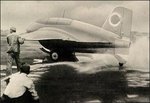Njaco
The Pop-Tart Whisperer
The Ki-61 Hein was built around the engine. Japan recieved a license to build the DB 601A, designated Ha-40 and in anticipation of this developed the airframe based upon this engine. Actually Kawasaki was ordered to build two aircraft for the engine. The Ki-60 was a failure. Similarities to the Bf 109abound. Early tests included a mock combat with a captured P-40 ad a Bf 109E. Apparenty proved superior to both planes and production immediately ordered.
Now from Aero Series 12 Heinkel He 100:
"On October 30, 1939, a Soviet commission headed by Col. Gussewand and Col. Shevtshanko to inspect (at Marienehe) and perhaps purchase the He 100. A member of this team was Alxander Yakoulew who spent much of his time inspecting the plane carefully. The Soviets purchased 3 He 100D-1s, which served in the USSR for design studies which led to the developements of the YAK-3 and YAK-9. A Japanese commission arrived right on the heels of the Soviet commission, thus making negotiations with either a little difficult to arrange. This commission was headed by Navy Capt. Wada and Capt. Kikuoka. The Japanese purchased the 3 He 100D-0 models and the export designation was AX-He-1. One can see the direct development of this to the Ki-61."
Others were sold to Hungary but there were no production models from any foreign country, just design.
Now from Aero Series 12 Heinkel He 100:
"On October 30, 1939, a Soviet commission headed by Col. Gussewand and Col. Shevtshanko to inspect (at Marienehe) and perhaps purchase the He 100. A member of this team was Alxander Yakoulew who spent much of his time inspecting the plane carefully. The Soviets purchased 3 He 100D-1s, which served in the USSR for design studies which led to the developements of the YAK-3 and YAK-9. A Japanese commission arrived right on the heels of the Soviet commission, thus making negotiations with either a little difficult to arrange. This commission was headed by Navy Capt. Wada and Capt. Kikuoka. The Japanese purchased the 3 He 100D-0 models and the export designation was AX-He-1. One can see the direct development of this to the Ki-61."
Others were sold to Hungary but there were no production models from any foreign country, just design.





